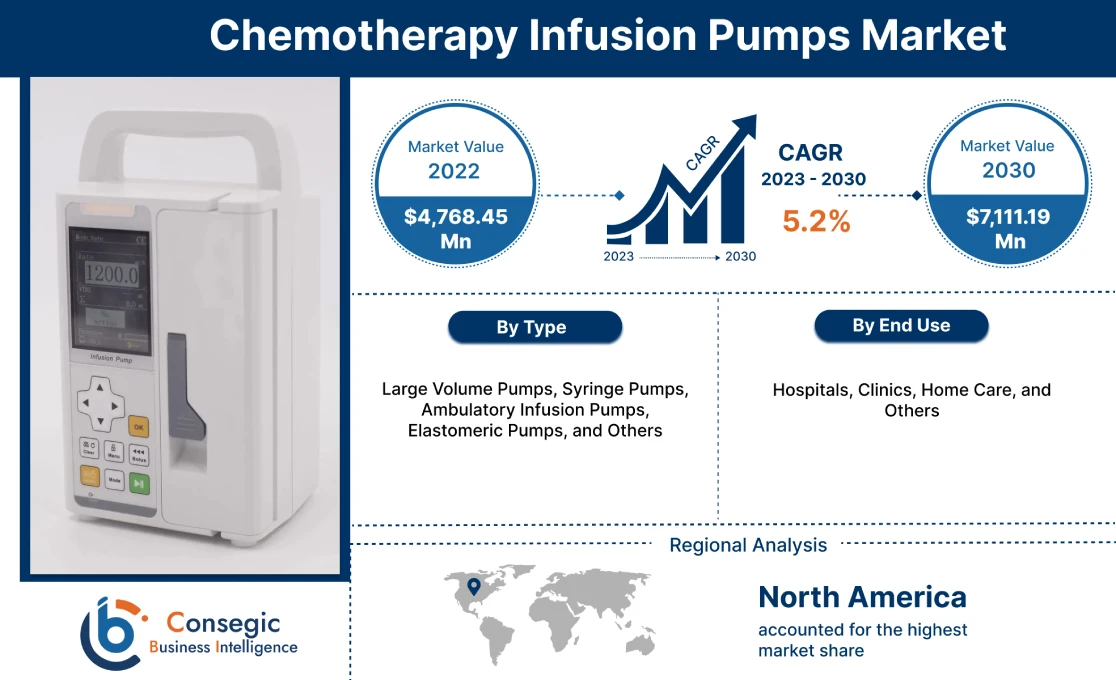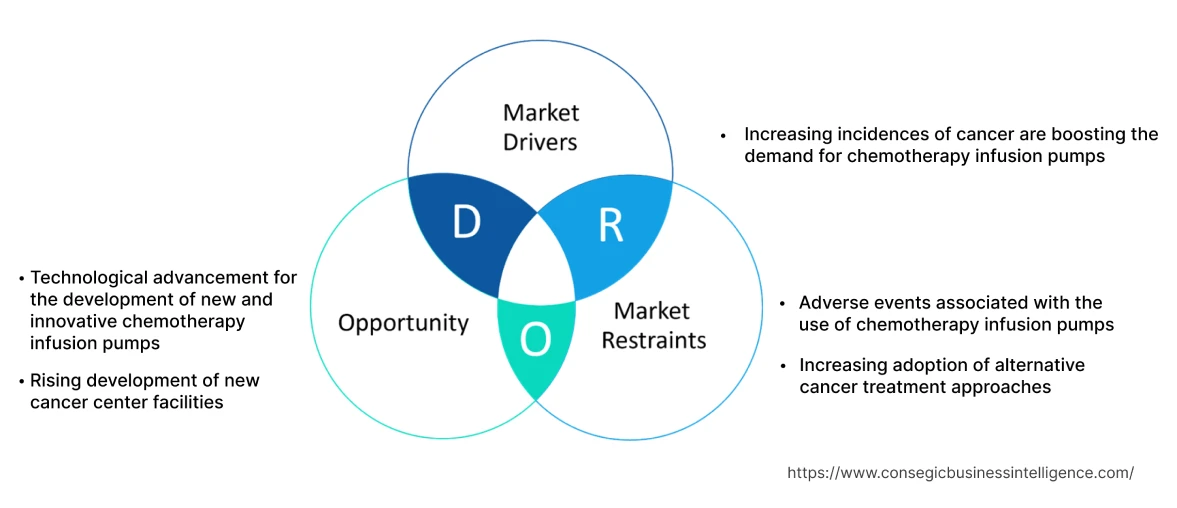- Summary
- Table Of Content
- Methodology
Chemotherapy Infusion Pumps Market Size :
Consegic Business Intelligence analyzes that the Chemotherapy Infusion Pumps Market is growing with a CAGR of 5.2% during the forecast period (2023-2030), and the market is projected to be valued at 7,111.19 Million by 2030 from 4,768.45 Million in 2022.
Chemotherapy Infusion Pumps Market Scope & Overview:
Chemotherapy is a cancer treatment that involves the usage of drugs for the cure, control, and palliation of cancer. Cancer can be cured and controlled using chemotherapy in the early stages. Chemotherapy treatment widely requires the usage of devices such as chemotherapy infusion pumps for the administration of antibiotics and chemotherapy drugs in a controlled manner. The chemotherapy infusion pumps is composed of a hard plastic bottle that comprises a balloon. The balloon holds the chemotherapy drug which is further administered into the patient's body, and the flow restrictor present outside the balloon restricts the flow of the chemo.
Various types of chemotherapy infusion pumps are commercialized in the market namely, large volume pumps, syringe pumps, ambulatory infusion pumps, and others. The different types of chemotherapy infusion pumps offer different functions such as,
- Large volume pumps are used to infuse large volumes of nourishment and medication fluids into the patient's body.
- A syringe pump is a medical device that intravenously infuses drugs, fluids, and nutrients into the patient's body.
- Ambulatory infusion pumps are portable or wearable small battery-powered pumps that slowly deliver chemotherapy drugs or antibiotics inside the body.
Chemotherapy Infusion Pumps Market Insights :
Key Drivers :
Increasing incidences of cancer are boosting the demand for chemotherapy infusion pumps
Cancer is one of the major causes of death globally after cardiovascular diseases. The most common types of cancers among men are lung, prostate, colorectal, stomach, and liver cancer. However, breast, colorectal, lung, cervical, and thyroid cancer are the common types of cancer among women. Chemotherapy is a drug treatment that uses powerful chemicals to kill fast-growing cancer cells in the body using various types of chemotherapy devices including infusion pumps. Such types of infusion pumps are used to draw blood and give treatments, including blood transfusions, intravenous fluids, and chemotherapy drugs at a slow and controlled rate into the body.
For instance, according to the World Health Organization (WHO), in 2021, 20 million new cases of cancer were diagnosed. Every year, approximately 400,000 children develop cancer and the cases will continue to rise over the forecast period. Hence, the increase in the cancer-afflicted population is a key driver of the chemotherapy infusion pumps market.
Key Restraints :
Adverse events associated with the use of chemotherapy infusion pumps
During an emergency condition, infusion pumps can sometimes fail to activate pre-programmed alarms or are likely to activate an alarm in the absence of an emergency. Such types of software errors or defects lead to improper programming of medication doses or infusion rates.
Further, the occurrence of premature battery failures of infusion pumps and sparks or pump fires create risks to patient's life. The aforementioned adverse events result in several injuries and deaths, as a result, few organizations declared infusion pumps as hazardous technology. For instance, the ECRI Institute of Plymouth Meeting, Pennsylvania, has listed infusion pumps as the most hazardous healthcare technology. Hence, such type of adverse events associated with the use of infusion pumps is hampering the market growth.
Increasing adoption of alternative cancer treatment approaches
Chemotherapy is associated with various side effects including nausea, hair loss, and fatigue, among others. These adverse side effects lead to patient discomfort resulting in a patient shift towards alternative treatment approaches. Moreover, the additional safety concerns as well as the risk of infection associated with chemotherapy devices limit the adoption of chemotherapy infusion pumps. Further, the presence of alternative treatments such as targeted therapies, immunotherapies, and other approaches for cancer treatment is likely to restrict the adoption rate of chemotherapy treatment, which hamper the demand of chemotherapy infusion pumps market.
Future Opportunities :
Technological advancement for the development of new and innovative chemotherapy infusion pumps
Traditional infusion pumps deliver fluids, antibiotics, chemotherapy drugs, and nutrients into a patient's body. However, the inadequate user interface design associated with traditional infusion pumps along with the alarm errors and excessive resistance causing pressure buildup and failure of the syringe pumps is resulting in a demand for improvised infusion pumps.
The advancement in technology provides opportunities to the key players for the development of improved infusion pumps that are anticipated to offer benefits such as high-precision drug delivery control, enhanced safety features, avoiding manual tube flushing problems, advanced connectivity, and remote programming. For instance, in March 2022, MicroPort Lifesciences received marketing approval from NMPA for an AutoEx chemotherapy pump. AutoEx comprises a drive unit and a disposable pump infusion unit. The disposable pump infusion unit comprises two fluid reservoir bags, which can be automatically switched by a pre-programmed procedure. Such type of advanced programming helps to avoid the trouble of manual tube flushing by healthcare providers and is likely to save a large number of medical resources for healthcare institutions. Hence, the growing development of advanced technology-based infusion pumps for chemotherapy treatment is expected to boost the chemotherapy infusion pumps market.
Rising development of new cancer center facilities
Chemotherapy infusion pumps are devices used to deliver chemotherapy drugs and antibiotics into a patient's body and are an ideal option for cancer hospitals to ensure efficient chemotherapy treatment. These devices provide antibiotics, chemotherapy medication, pain medication, and hydrating fluids in controlled amounts. The surge in the cases of cancer, and increasing government initiatives for the healthcare infrastructure, among others, are some of the critical factors accelerating the development of highly advanced new cancer center facilities. These factors will drive the demand for efficient chemotherapy treatment, resulting in increased adoption of advanced chemotherapy devices such as infusion pumps. For instance, according to the Ministry of Health and Family Welfare, in India, 708 district NCD Clinics, 301 district daycare centers, and 5671 community health center NCD clinics are in the construction phase.
Thus, the advent of new cancer center developments to boost the treatment of various cancers is further increasing the revenue growth of the chemotherapy infusion pumps market at the global level in the forecast period.
Chemotherapy Infusion Pumps Market Report Insights :
| Report Attributes | Report Details |
| Study Timeline | 2017-2030 |
| Market Size in 2030 | USD 7,111.19 Million |
| CAGR (2023-2030) | 5.2% |
| By Type | Large Volume Pumps, Syringe Pumps, Ambulatory Infusion Pumps, Elastomeric Pumps, and Others |
| By End User | Hospitals, Clinics, Home Care, and Others |
| By Region | North America, Europe, Asia-Pacific, Latin America, and Middle East & Africa |
| Key Players | BD, ICU Medical, Inc., Terumo Corporation, B. Braun SE, Baxter International, Inc., Fresenius SE & Co. KGaA, vTitan Corporation Pvt Ltd, Moog Inc., ZynoMed, and Micrel Medical Devices SA |
Chemotherapy Infusion Pumps Market Segmental Analysis :
By Type :
The type segment is categorized into large volume pumps, syringe pumps, ambulatory infusion pumps, elastomeric pumps, and others. In 2022, the syringe pumps segment accounted for the highest market share of 31.05% in the overall chemotherapy infusion pumps market. A syringe pump is a type of motor-driven pump that comprises one or more syringes to administer an accurate and precise volume of fluid into the patient's body.
Several key players adopt innovative ways for the creation of advanced syringe pumps to cater to the growing needs of various end-use industries. For instance, in March 2020, Longerpump announced the launch of new industrial syringe pumps SP1-CX and MSP1-CX. Such type of pumps provides more reliable and stable solutions for high-precision fluid transfer applications which is a key driver for the growth of the chemotherapy infusion pumps market.
However, the ambulatory infusion pumps segment is expected to be the fastest-growing segment in the market owing to their widespread usage for home infusion therapy and delivery of intravenous (IV) and arterial infusions. Such types of pumps are designed to be lightweight, wearable, and portable which provides mobility to patients that require regular or continuous IV infusions, thereby, driving the growth of the chemotherapy infusion pumps market.
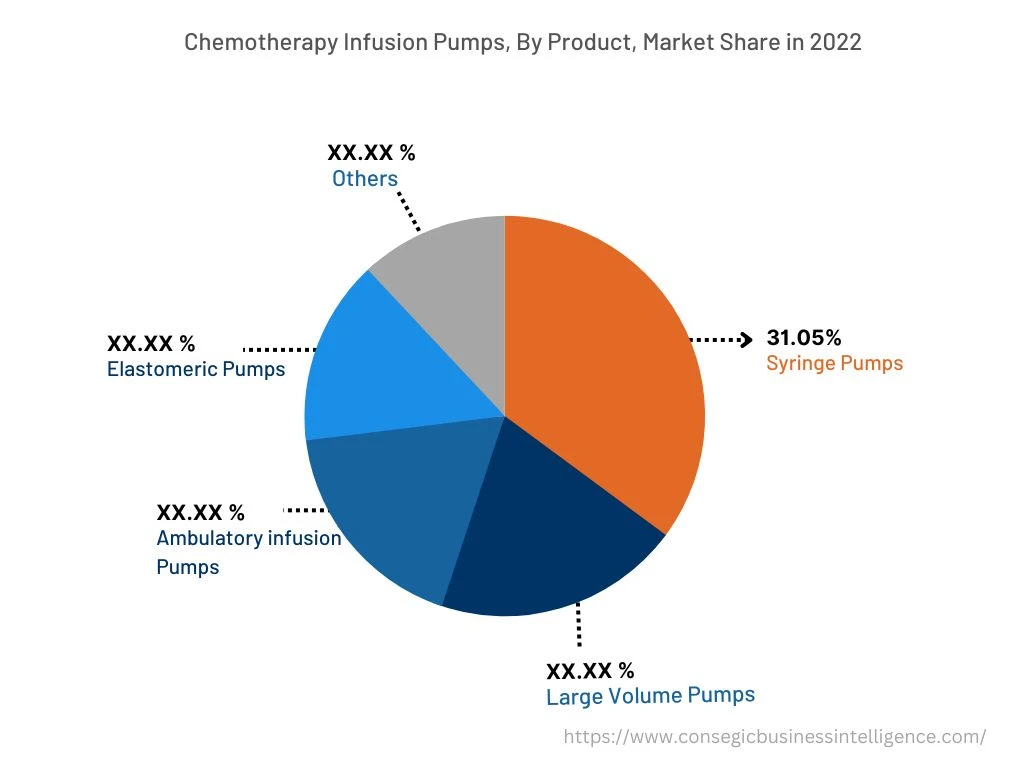
By End-User :
The end-user segment is classified into hospitals, clinics, home care, and others. In 2022, the hospital segment accounted for the highest market share and is also expected to grow at the fastest CAGR over the forecast period in the chemotherapy infusion pumps market. This is due to the rising cases of cancer, and the adoption of advanced chemotherapy devices including infusion pumps in the hospitals to ensure the proper chemotherapy treatments.
For instance, Baxter International Inc. received clearance for the new Novum IQ syringe infusion pump (SYR) with Dose IQ Safety Software. The Novum IQ Syringe Infusion Pump can fully integrate with hospital electronic medical records (EMRs) through Baxter's IQ Enterprise Connectivity Suite. Further, Novum IQ provides clear visualizations of infusion data across a hospital system leading to the security of patient data. Hence, the growing adoption of advanced technology-based infusion pumps in hospitals for chemotherapy treatment is expected to boost the chemotherapy infusion pumps market.
By Region :
The regional segment includes North America, Europe, Asia Pacific, Middle East and Africa, and Latin America.
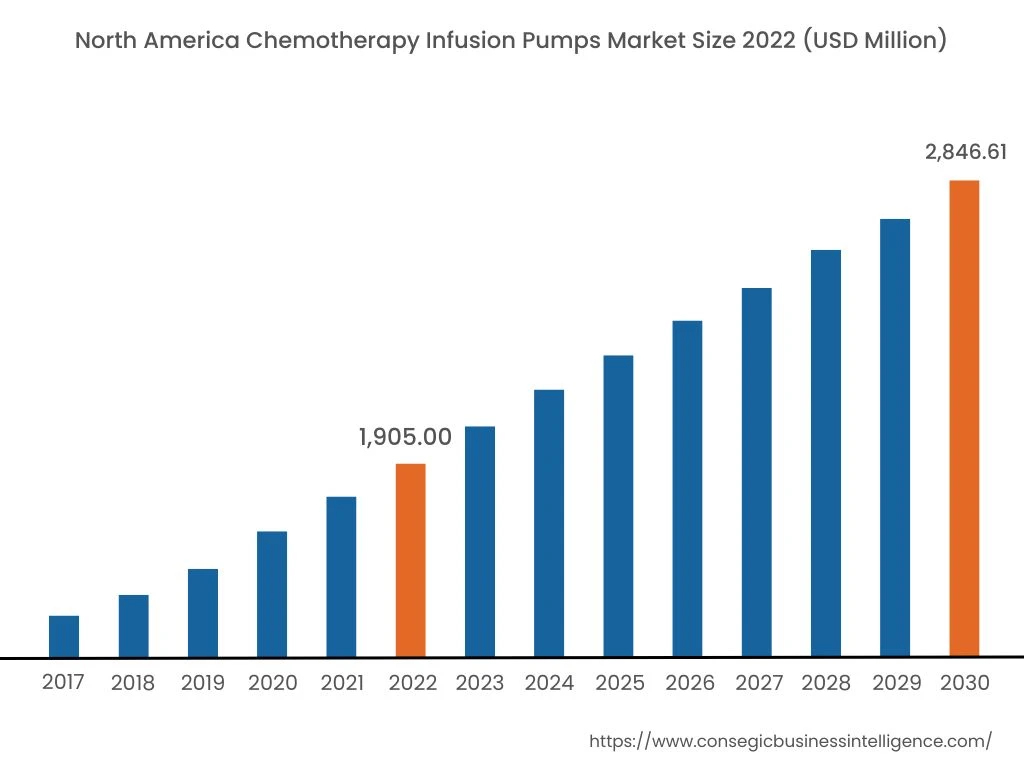
In 2022, North America accounted for the highest market share of 39.95% and was valued at USD 1,905.00 million, and is expected to reach USD 2,846.61 million in 2030. In North America, the U.S. accounted for the highest market share of 72.05% during the base year 2022 owing to the increasing growth of advanced health technologies and rising private player's investments in the development of hospitals.
Further, the market players in the region are adopting various business strategies such as mergers and acquisitions, product innovations, and others to cater to the growing needs of various end-users. For instance, in January 2022, ICU Medical acquired Smiths Medical. The addition of Smiths Medical syringe and ambulatory infusion devices, vascular access, and vital care products to the ICU Medical's existing business helped to generate adequate revenue in the market. As a result, this acquisition will increase the stability of the medical supply chain, thereby driving the growth of the chemotherapy infusion pumps market
Moreover, Asia Pacific is expected to grow at the fastest CAGR of 6.2% during the forecast period due to the increasing development of new hospital facilities, the rising investment in healthcare sectors, and growing cases of cancer that require refined chemotherapy treatment, particularly in countries such as China and India.
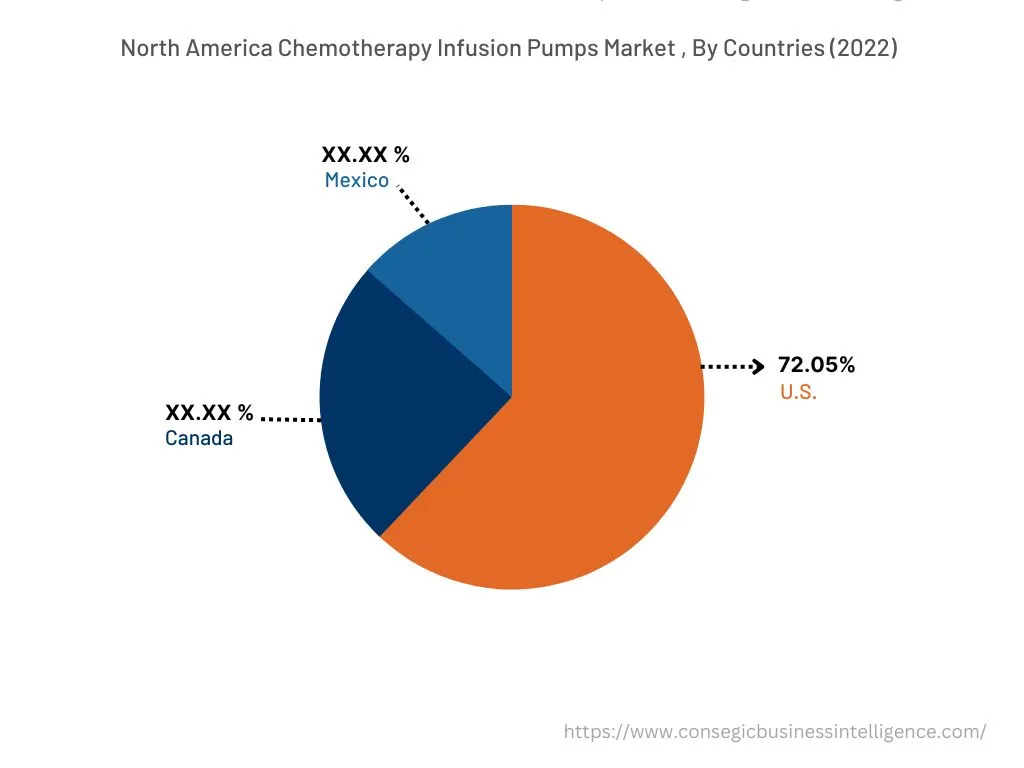
Top Key Players & Market Share Insights:
The chemotherapy infusion pumps market is highly competitive, with several large players and numerous small and medium-sized enterprises. These companies have strong research and development capabilities and a strong presence in the market through their extensive product portfolios and distribution networks. The market is characterized by intense competition, with companies focusing on expanding their product offerings and increasing their market share through mergers, acquisitions, and partnerships. The key players in the market include -
- BD
- ICU Medical, Inc.
- Terumo Corporation
- B. Braun SE
- Baxter International, Inc.
- Fresenius SE & Co. KGaA
- vTitan Corporation Pvt Ltd
- Moog Inc.
- ZynoMed
- Micrel Medical Devices SA
Recent Industry Developments :
- In December 2022, Terumo Corporation announced the launch of “G-Lasta Subcutaneous Injection 3.6 mg BodyPod”, a drug-device combination product that is co-developed with the help of Kyowa Kirin Co., Ltd.
- In August 2022, Mindray Medical announced new standards for infusion pumps with the BeneFusion n Series Infusion System for offering patient safety, operational simplicity, interoperability, and data synergy.
Key Questions Answered in the Report
What was the market size of the chemotherapy infusion pumps market in 2022? +
In 2022, the market size of chemotherapy infusion pumps was USD 4,768.45 million
What will be the potential market valuation for the chemotherapy infusion pumps market by 2030? +
In 2030, the market size of chemotherapy infusion pumps will be expected to reach USD 7,111.19 million.
What are the key factors driving the growth of the chemotherapy infusion pumps market? +
Increasing incidences of cancer is the key factor driving the growth of the chemotherapy infusion pumps market.
What is the dominating segment in the chemotherapy infusion pumps market by type? +
In 2022, the syringe pump segment accounted for the highest market share of 31.05% in the overall chemotherapy infusion pumps market.
Based on current market trends and future predictions, which geographical region will have the fastest impact on the chemotherapy infusion pumps market's growth in the coming years? +
Asia Pacific is expected to be the fastest-growing region in the market during the forecast period.
